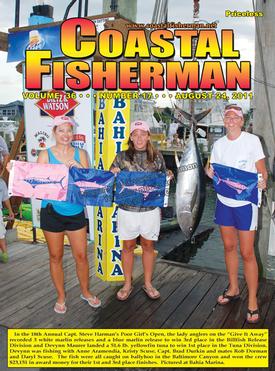


Article by Pat Schrawder
 SHAKESPEARE INTRO’S NEW PHASE III MARINE ANTENNAS
SHAKESPEARE INTRO’S NEW PHASE III MARINE ANTENNAS
No matter what type of communications device you choose, the best unit made won’t perform as you hope unless it is connected to an equally good antenna. All too often, boaters will pick a really good radio and then look for the cheapest antenna they can find. This totally defeats the purpose of buying the good radio. The two work as a system.
First and foremost, when picking out an antenna you have to remember that antennas are “cut” to certain frequency ranges and they must match your communications device. In other words, to use an antenna for your VHF, it must be a designated VHF antenna manufactured in the frequency range of 156 MHz to 162 MHz. If you are purchasing an antenna, make sure you specify the type of radio with which it is being used.
Antennas are rated by type of construction, height and gain. In general, the higher the gain (as expressed in decibels) and the taller the antenna, the better range you will get. However, your antenna has to be practical for your size boat. If an antenna is longer than 8 feet, it will need to be supported by both a base mount and a top mount. The top mount will help stabilize the whipping action of the antenna and hopefully prevent breakage. The higher the antenna is mounted on the boat, the better it will perform but, once again, you need to be sensible about this. If your boat has a hard top, it is usually good to put the antenna(s) on top of it. That gets them out of your way and provides the height you need. In many cases, you can even use one of the good quality 5’ antennas for this situation. Even though you have reduced your total height, there is less whipping action and less chance of breakage.
All antennas are not of the same quality, even within the same manufacturer’s line. Shakespeare, for example is one of the leaders in the marine antenna field. They make antennas for all types of applications, but they come in varying degrees of quality construction and performance. The prices vary depending on their construction and performance ratio. They have just announced a new line of antennas they call Phase III, and state that they are the highest grade quality they have ever manufactured. Let’s take a look at what makes them different from what was and still is currently on the market.
Antennas are made up of a Fiberglas housing that contains a wire running its length and, in some cases, a series of phasing elements that tune it for the frequency. These are suspended and/or held in place by various means. Often it is a number of foam “donuts”. However, the Phase III antennas are totally foam filled to isolate the elements (radiators) and protect them from vibration and moisture for better performance and for longevity. Shakespeare has silver plated their brass and copper elements for improved electrical performance and has used stranded copper tinned inner wiring for maximum signal strength.
If we take a look at their outside construction, we can see that they have used high strength aircraft grade coatings. In other words, they have used high grade Fiberglas with a smooth appearance and have coated it with a clear coating to make a smooth, long lasting outer shell that will not leave you with Fiberglas splinters in your hands when touching them years from their purchase. Most interesting and clever is the design of the bottom ferrule. Not only is it made of stainless steel, but it has 12 facets for easier gripping and it is made in two parts. The antenna itself has a threaded collar and an “N” connector permanently affixed to the bottom of the antenna. This is designed to be coupled with a short matching SS mast that is the part that screws onto the mount and then is connected to the antenna by the aforementioned threaded collar. In other words, you run your antenna cable from the radio up to the location of the antenna. Run the cable through the provided side hole of the short mast and install the connector. Go ahead and screw the short mast onto the mount, then place the antenna on the mast, fitting the “N” connector to the corresponding connector at the base of the antenna and then screw the collar down onto the mast. I know this may sound confusing but it is really quite simple and very well designed.
Topping off the advantages of these Phase III antennas is their 5-year warranty.
The price of these antennas is somewhat more than the Shakespeare’s Classic line or their better grade Galaxy line, but their features may make the price well worth it. I would not pull my current antennas off the boat for one of these but, if you have to replace an antenna or you are getting a new boat with electronics, you might want to consider one. If not now, just keep them in mind for when you do need one.
Pat and her husband, Larry are owners of L&L Marine Electronics on Golf Course Road in West Ocean City, MD.